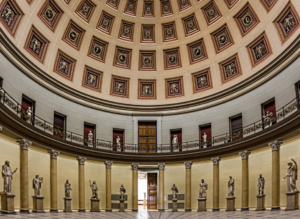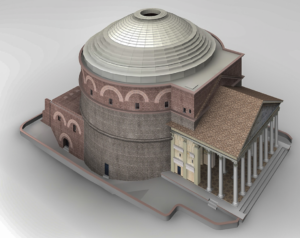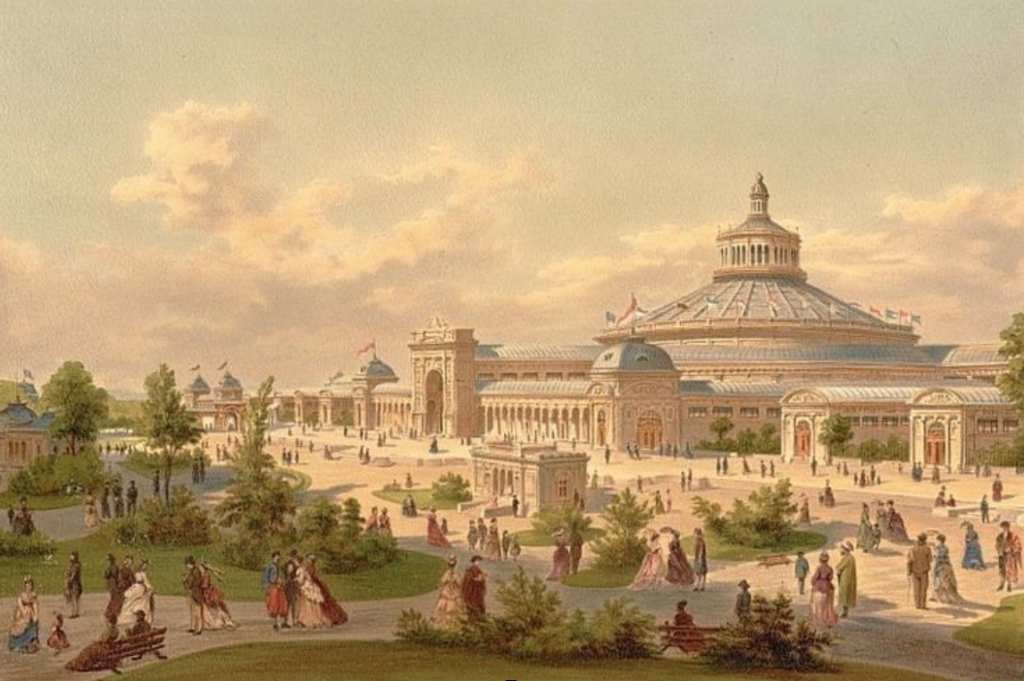
A rotunda (Latin rotundus, Italian rotonda) is a building with a circular floor plan. It can be simple or take on monumental proportions, serve sacred or profane functions and can be found in architecture in all eras. The interior is often, but not necessarily, structured by conches or niches and is vaulted by a dome.

Antiquity
The Monopteros and the Tholos have been known as simple rotundas since Greek and Roman antiquity. The treasury of Atreus in Mycenae with its corbelled vault can be cited as an early example of this. The best-known example of a monumental central building in the form of a rotunda is the Pantheon, which was renovated under Emperor Hadrian.
Early Christianity
The Constantine’s Church of the Holy Sepulcher in Jerusalem (begun in 326) proved to be groundbreaking in the history of church building; Here the rotunda over the tomb of Jesus with a two-story ambulatory and a three-story, domed central building is part of an original overall complex, which also included a courtyard with a columned gallery and a five-aisled basilica.
Church of the Holy Sepulcher, today’s floor plan of Santo Stefano Rotondo in Rome, consecrated in 470, is a first example in the West of early Christian church buildings based on the model of the Jerusalem Church of the Holy Sepulcher. This is also the last monumental building of the Western Roman Empire. In Syria, simple rotundas can be seen within early Christian excavation sites (Bosra Cathedral, 512/513).
Renaissance
In this era, the monumental buildings of antiquity are reconnected. The starting point is Italian architecture (Venice, Florence, Rome). The central rotunda is seen as the completion of a self-contained architectural harmony in which the horizontal and vertical forces are equivalent. Well-known domed rotundas can be found in many central buildings by Andrea Palladio (for example in the Villa La Rotonda), Filippo Brunelleschi and Donato Bramante. Both Leon Battista Alberti and Leonardo da Vinci dealt with architectural theory and also produced numerous designs that were not implemented.
For the most important and best-known rotunda with the world’s largest cantilever dome, St. Peter’s Basilica in Rome, several top artists (including Bramante and Michelangelo) had provided groundbreaking designs; In the end a model by Giacomo della Porta was executed.
Baroque
The art of monumental buildings with a central rotunda finds elaborate forms in Italy, but is also widespread north of the Alps.
Well-known examples are Santa Maria della Salute in Venice, the Frauenkirche in Dresden, the Karlskirche in Vienna, and the Invalides Cathedral in Paris. In Germany and Austria, this type of central building with a rotunda is often used as a pilgrimage church (example: Maria Birnbaum in Bavaria).
In the garden art emerging in this era, the ancient type of monopteros rotunda was revitalized in the form of a small pavilion (Gloriette). Fountains and water features in baroque palace complexes are also often circular; The term fountain rotunda has become apparent in general and tourist usage, but this is unspecific and not defined in architectural dictionaries.
Baroque cemetery chapels also often constitute or contain a rotunda.
Newer and modern-era architecture

In classicism, monumental rotundas build on the tradition of the Pantheon (San Francesco di Paola in Naples; Gran Madre di Dio in Turin). Domed buildings with a central rotunda are common in France (Panthéon in Paris), Germany (Paul’s Church in Frankfurt) and Denmark (Frederiks Kirke, Copenhagen). In the USA, the Rotunda at the University of Virginia used the round shape for a representative library building and inspired several subsequent buildings, for example at the Massachusetts Institute of Technology (MIT). The Monopteros is a very popular object in park and garden design in classicism.
The largest building ever called a “rotunda” was the Vienna Rotunda, built in 1873, the central exhibition building of the 1873 World’s Fair; It was the largest dome in the world until it was destroyed by fire in 1937.
Sacré-Cœur, the classic example of Parisian historicism, has several side rotundas in addition to the central one. The Capitol Records Building in Los Angeles, built in 1955/1956, is considered the first office rotunda.
